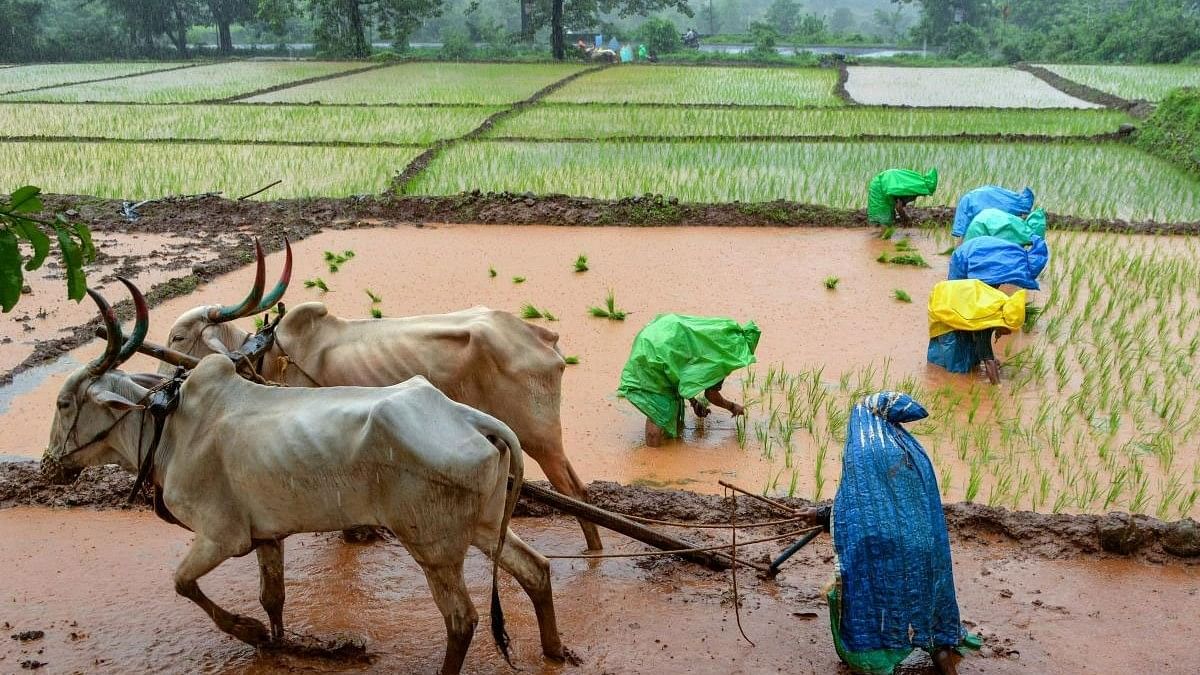
A representational image for agriculture.
Credit: PTI File Photo
The early arrival of the southwest monsoon has accelerated sowing activities across Karnataka.
Six days into the monsoon, 12% of kharif sowing activities have already been completed. By June 7, the total sown area was 9.849 lakh hectares, more than double that of the corresponding period last year.
In 2023, the southwest monsoon arrived several days late and was deficient, leading to an intense drought spell across the state. In the first week of June last year, the kharif sown area was only 4.182 lakh hectares.
A timely and strong southwest monsoon is crucial for sowing kharif (autumn) season crops, which are sown in June and July and harvested in September and October. This year, with the monsoon arriving three days early in Karnataka, the Department of Agriculture has set the total target area for kharif sowing at 82.48 lakh hectares. The forecast of an above-normal monsoon has been beneficial.
Official data shows that the kharif sowing area increased from 2.364 lakh hectares on May 31 to 9.849 lakh hectares by June 7. Sowing activities have intensified in districts such as Chamarajanagar, Chikkamagaluru, Chitradurga, Hassan, Koppal, Mandya, Mysuru, Tumakuru and Ramanagara.
An official in the Department of Agriculture reported that in a target area of 57.51 lakh hectares, a total of 5.47 lakh hectares of foodgrains were sown by the first week of June, accounting for 10% of the sowing activities. This includes 3.22 lakh hectares of cereals and 2.24 lakh hectares of pulses.
He also mentioned plans to encourage higher cultivation of tur in the coming years to reduce imports. "More than 30% of India’s overall tur production comes from Karnataka. Our soil and weather conditions are suitable for tur cultivation, so we are aiming for higher yields and production."
However, data shows there has been no significant change in the area of tur cultivation over the years. While the target area for tur ranged from 15 lakh hectares to 17 lakh hectares between 2018 and 2021, it shrunk to 12 lakh hectares in 2022 and 13 lakh hectares in 2023. This year, the target area for tur is 15 lakh hectares.
Farmers are pleased with the early monsoon but are concerned about rising seed prices.
Chamarasa Malipatil, who cultivates paddy and cotton in Raichur's Manvi, said, "In Raichur, rainfall is not uniform across the district. If it rains in one village, it does not in another. Despite that, sowing activities have begun. In the next eight to ten days, widespread sowing will start."
According to him, seed prices have nearly doubled compared to previous years due to last year’s green drought. He had to pay nearly Rs 400-500 more for a kilogram of cotton seeds and Rs 800 more for a quintal of paddy seeds compared to last year. While prices depend on the variant and quality of seeds, his experience shows seed prices have increased significantly this year.
Government data indicates that while the overall demand for seeds of various kharif crops is 5.52 lakh quintals, Karnataka has 9.01 lakh quintals of seeds available.
Jayachandra Sharma, a farmer from Tumakuru's Tiptur, attributed the high prices despite the surplus availability of seeds to the higher cost of production due to last year’s drought, during which Karnataka saw a crop loss of over 33%.